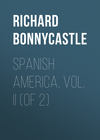Kitabı oku: «Spanish America, Vol. II (of 2)», sayfa 20
ARAUCANIA, or INDIAN CHILI,
Extends from the river Biobio in 36° to the south of Chiloe, in the 45° of south latitude, exceeding 420 miles in breadth, and also occupying from the 33° to the 45° south latitude, both the central and eastern ridges of the Andes. The nations who inhabit this extensive tract are the Araucanians, possessing the country between the Biobio and the Valdivia rivers, the Pacific and the Andes; the Puelches, who inhabit the western flanks of the Cordillera and its central valleys; and still farther north, on the Andes, adjoining Cuyo, the Pehuenches and the Chiquillanes, their territory lying as far north as the thirty-third degree of south latitude, or opposite to Santiago, the capital of Chili, and extending indefinitely to the east.
South of the Valdivia river, and as far as the forty-fifth degree, are the Cunches on the sea coast, and the Huilliches in the plains, near the western declivity of the Andes, which mountains are also occupied in this quarter by the Puelches.
All this country, to the north of the archipelago of Chiloe, is fertile and pleasant, consisting mostly of wide plains, agreeably diversified with mountains. That part which lies on the Andes possesses some beautiful valleys, but as the chain attains a great elevation the climate is cold. In these valleys, towards the east, salt and sulphur is plentiful; and the precious metals are by no means rare. Near Valdivia, immense quantities of gold were formerly found in the sands of the rivers and in alluvious grounds, but they are not worked at present, as the Spaniards are kept from those places by the natives.
In Araucania the vegetables and animals are the same as those of Spanish Chili; but the rivers and sea abound with fish in greater quantities than in the latter country.
The Araucanian nation is the most considerable and the most noted of all those which have been named as inhabiting Indian Chili; the others resemble them in their customs and persons, but are in a more savage state; we shall therefore only describe these extraordinary people, whose history forms so prominent a feature in the affairs of Chili. They are of a middling stature, well made, and of a strong muscular form and martial appearance. Their colour is the same as that of the other native American tribes, only rather clearer, and they have round faces, small eyes, and small feet; and many of their women are said to be beautiful. Accustomed to a hardy life; and breathing a pure air, these people live to an advanced age, and are not subject to many disorders. In character they are haughty, free, patient under fatigue, and very intrepid in danger; but are fond of strong liquors, which causes them to commit crimes.
Their dress consists of clothes fitted close to the body, and ponchos, or cloaks, which are made of cotton, and are so beautifully worked that they are sometimes worth a hundred and fifty dollars.
Their heads are girt with embroidered wool, in which is placed plumes of ostrich, flamingo and other beautiful feathers. The women wear a robe of woollen stuff, descending to the feet, and tied round the waist with a girdle, over which they put a small cloak. The hair is allowed to grow long, and is formed in tresses ornamented with a kind of false emerald and other gems; necklaces, bracelets, and rings on every finger, complete the female toilet. The national colour, which is worn by both sexes, particularly among the lower classes, is greenish blue.
These people never inhabit towns, but dwell in huts, occasionally placed near each other, though oftener dispersed on the banks of the rivers and in the plains; these habitations descend from father to son, and are not removed, except in case of absolute necessity. The cottages are remarkably neat, and are proportioned to the size of the family; they are surrounded with trees, under whose shades their repasts are made in summer; and the rich people display much plate on these occasions. At their marriages, funerals, and feasts, the utmost profusion of provision appears; and at these times fermented liquors are given in such quantities that they often occasion feuds.
Polygamy is practised by these people, every man having as many wives as he can maintain, it being deemed reproachful to remain unmarried. Instead of the husband receiving a portion with his wife, he pays a considerable sum to the parents for their permission to wed her; after he has obtained which, he carries off his bride without any further ceremony, excepting giving a feast to her relations. The first wife is regarded as the head of the family, the others being under her orders in respect to the management of the house; each wife has a separate apartment where she prepares food for her husband every day, and all present him once a year with a poncho or embroidered cloak, but the women are in general condemned to the laborious occupations.
Both sexes practise daily ablutions in the rivers, and are excellent swimmers.
Oratory is held in the highest esteem by these people; and their language, which is the ancient dialect of Chili, is very soft, harmonious, and rich. Molina in his description of Chili has given a full account of it, and says that it differs essentially from all the languages of the American tribes.
The government of that part of Chili inhabited by this nation is singular; they divide the territory into four parallel provinces, the maritime, the plains, the foot of the Andes, and that which lies on the sides of these mountains; each province is separated into five districts, and these are again subdivided into nine other portions.
The four provinces are governed each by a toqui or general, subordinate to whom are the Apo Ulmens; and on these, as far as military affairs are concerned, the Ulmens are dependent, each subdivision having its Ulmen or Cacique. All these magistrates have distinctive badges; the toqui a hatchet; the Apo Ulmen a silver-headed rod encircled by a ring; and the Ulmen a rod with a silver head; and these dignities are hereditary. The whole are occasionally combined in a general council, which meets on a plain; the chief occasion to assemble this council being to elect a supreme toqui for the command of the army when it is about to take the field; and any native is eligible to this appointment.
Their wars are terrible, and as they are excellent horsemen, the Araucanian cavalry is very formidable, their arms being swords and lances; those of the infantry, clubs and pikes; their onset is furious, but always conducted with order, and though swept down in rants by the cannon, they close with their Spanish enemies, and fighting hand to hand, are frequently victors in spite of the superiority of European discipline and arms.
After a great victory they sacrifice a prisoner to the manes of their warriors who have fallen in battle; and this ceremony is said to be attended with some disgusting circumstances, such as the toqui and chiefs sucking the blood from the panting heart of the victim, which is cut for that purpose from his breast.
These people have always resisted the attempts of the English and Dutch to land on the shores of Chili; they were seen by Sir Francis Drake in his celebrated voyage round the world, in some of the islands near the coast, and subsequently they drove the Dutch from several points on which they had landed.
They have hitherto frustrated all the attempts of the Spaniards to conquer their country, and being in strict alliance with the surrounding nations, keep the Europeans at defiance.
The Araucanians are said to wander over the Andes with the Puelches, in order to attack the convoys of merchandize and the travellers going from Buenos Ayres to Chili through the Pampas; and have even penetrated in the disguise of friendly Indians, as far as Buenos Ayres itself.
We shall conclude this account of Spanish America with a short description of a Spanish settlement formerly made in the Straits of Magalhaens, and of the islands on the coasts of South America belonging to or claimed by that power.
The Straits of Magalhaens and others in their vicinity being at present, though it is to be hoped that the voyage now performing by order of the British Government will not long allow them to remain so, the only passage from the Atlantic into the Pacific Ocean, it may not be uninteresting to state that they were discovered by Ferdinand Magalhaens a Portuguese navigator, who having turned his mind to the circumstance of the extreme probability of there being a communication between the two oceans which had in vain been sought for by Columbus and his followers, offered to conduct an expedition to explore the southern part of America for this purpose.
Meeting with a denial from his own court, he went to Madrid, where, from his known talents and previous voyages, he received the utmost favour; a fleet was fitted out, and, being placed under his orders, Magalhaens sailed from the Guadalquivir on the 10th of August 1519, and discovering the coast of Patagonia, proceeded along its shores to the south, where the land bearing away to the west, the admiral followed it, till he found his squadron in the straights that now bear his name, through which he passed, and entered the great South Sea on the 28th of November, 1520; proceeding through it till he discovered the Ladrones, and in one of those isles was killed in a skirmish with the natives; after which, one of his ships only arrived in Spain by way of the Cape of Good Hope, on the 7th of September, 1522, having been absent three years and twenty-seven days; and having had the honour of being the first to circumnavigate the globe.
Sir Francis Drake, following Magalhaens by the same route into the South Sea, and taking much treasure and many ships from the people of Chili, Peru and Mexico, it was determined by the Spanish court that the newly discovered passage should be explored and fortified. With this view Sarmiento, the best naval officer in the service, was selected in Peru to pass the Straits from the South Sea into the Atlantic; he accordingly performed this voyage; and so plausible were the representations he made to the cabinet of Madrid, that Philip II. ordered twenty-three ships to be fitted out, with 3500 men, under Don Diego de Valdez, and Sarmiento with 500 veterans was directed to settle and fortify such positions as he deemed the best.
It was more than two years before this fleet arrived at its destination: but as soon as it entered the straits, Sarmiento built a town and fort at the eastern entrance, which he named Nombre de Jesus and in which he left 150 men; fifteen leagues farther to the west he erected another fortress, in the narrowest part of the straits, and In 53° 18' south latitude, where he built his principal town, which he called Ciudad del Rey Felipe. This was a regular square, with four bastions, and is said to have been excellently contrived. In it was placed a garrison of 400 men and thirty women, with provisions for eight months: but on the return of Sarmiento into the Atlantic he was taken by an English ship.
The garrison, for want of succour, fell a prey to disease and famine, and on January the 7th, Sir Thomas Candish found only one Spaniard, out of twenty-three who had remained alive, which were all that had escaped of the whole colony; the twenty-two others had set out to find their way to the Rio de la Plata over land: but as they were never heard of, it is conjectured they must have perished miserably in the deserts of Patagonia.
Thus ended this seemingly well-ordered expedition; since which time the Spaniards have not attempted to resume the colony; finding that the straits were too wide to fortify, and that other passages existed to the south, which were equally good for the purposes of the navigator.
ISLANDS ON THE COASTS OF SPANISH SOUTH AMERICA
Commencing the description of the Spanish South American islands from the coasts of Chili, our attention is first led to the islands of Juan Fernandez, three in number; the largest, which alone properly bears that appellation, is in 33° 40' south latitude, and 80° 30' west longitude, distant from Chili 110 leagues, and was discovered by a Spaniard, who gave it his name, in 1563. This island was so much spoken of by navigators in early times that it was supposed to be a terrestrial paradise. It is, however, in fact, merely a small spot, rising out of the ocean to a considerable height, not more than four leagues in length from east to west, and generally mountainous, but there are some fine valleys and plains, which are full of trees and herbage. The hills towards the north are also covered with large woods, but those on the south are destitute of timber; every place is, however, overspread with coarse grass, which grows to the height of six feet. Among all the species of trees there are few of the tropical kinds, owing to the coldness of the climate; for being surrounded by the sea, it is even cooler here than on the coast of Chili, under the same parallel: but the European and American fruits peculiar to these latitudes flourish and grow abundantly.
Juan Fernandez has been the abode of several English navigators in the voyages round the world, and into the Pacific, from the circumstance of its being excellently adapted as a place of shelter and refreshment to squadrons or vessels cruizing against the trade of Peru and Chili; but the government of the former country made a settlement here in 1750, which completely prevented all vessels from touching here excepting those belonging to powers in amity with Spain. Its western side is composed of cliffs rising perpendicularly out of the sea, but the north-west point is the first anchoring place, and here the Spaniards have a guard-house and battery. About half a mile east north-east of this is the great bay, where the anchorage is close to the shore; and in this bay is seated the village or principal settlement; in a fine valley between two high hills. A battery of five guns on the right commands the road, and there is another on the left, with seven embrazures to the anchorage, and seven towards the town.
In this village the houses amount to about forty; but there are several dispersed over different parts of the island. Each house has a garden, with grape vines, fig, cherry, plum and almond trees, and plenty of vegetables.
The officer who commands at this island is sent from Chili, in which government it is included, and the island is called La de Tierra by the Spaniards, on account of its lying nearer the shore of Chili than the next largest, which is distinguished by the name of Mas-afuera, or the farthest, and is 80 miles west from Juan Fernandez, in 80° 46' west longitude, and 33° 45' south latitude. This last is very high and mountainous, and at a distance appears one hill; its form is triangular, and seven or eight leagues in circuit; the southern part is much the highest, and on the north end are some clear spots, but the rest is covered with wood. Several parts of the coasts of this isle afford good anchorage, but the bottom is generally deep; and it abounds in goats, which are easily caught and afford a good supply of fresh provision. On the south-west point of the island is a pierced rock, which proves a good mark for the anchorage on the western shore.
Mas-afuera contains plenty of wood and fresh water, falling in cascades from the high ground of the interior; but these articles cannot be procured without difficulty, on account of the rocky nature of the shore causing the surf to beat violently. Several birds, and amongst these large hawks, are seen on the land, and hovering over the fish which abound on the shores, and may be easily caught. Sea wolves, seals, and other aquatic animals, are also very common.
Off the south-western extremity of Juan Fernandez is a small uninhabited isle, or rather rock, named Isla de Cabras, or Isle of Goats.
These islands are noted for having been the residence of two persons whose adventure gave rise to the novel of Robinson Crusoe. The one was a Mosquito Indian left there by the Buccaneers, and the other Alexander Selkirk, a Scotchman, also left there by his ship, and who lived four or five years on Juan Fernandez, subsisting upon the goats he caught, which were introduced into the islands by Fernandez, the discoverer, who settled and died in La de Tierra.
In proceeding to the north from these, the next isles of any consequence off the coasts of Peru, are those named St. Felix and St. Ambrose; but these are mere rocks of some extent and very high, on which innumerable seals and marine animals are found. They are not more than five miles in circumference, and are four leagues and a half distant from each other, between 26° 19' and 26° 13' south latitude, and between 79° 41' and 79° 26' west longitude.
On the coast of Peru, opposite the town of Pisco are the Isles of Lobos, or the Sea Wolves, where numbers of seals and other aquatic animals may be caught; they are also, however, mere rocks; north-north-west of these rocks is the small isle of Sangallan in 13° 45' south latitude, famous for seals and sea wolves, and north of this are the isles Chinca, Pachacamac, and St. Lorenzo, all small, but the latter of which is famous as forming the road of Callao, being the place where the Dutch fortified themselves in 1624, when they made an attempt against Lima.
North of these are the Farellones de Huara, which are dangerous rocks, and the isles de Saint Martin, de Santa, and de Chao, also very small, and close to the coast of Peru.
The next are the Lobos de Mar, formerly the resort of the Buccaneers, and the Lobos de Tierra, the first sixteen leagues from the shore, and the latter close to it; they are twelve miles from each other, in 6° 25' and 6° 45' south latitude, but are unimportant.
North of these, in the gulf of Guayaquil, is the large island of Puna already mentioned.
The next on the coast of New Granada is Salengo, a small isle near Cape Santa Elena, and still further is La Plata, the place where Sir Francis Drake divided his plunder, and is a very small isle close to the coast, in 1° 10' north latitude, which is followed at a considerable distance on the shore of Atacames, by the Isla del Gallo, a small uninhabited spot, furnishing good wood and water, in 2° 28' south latitude, and 76° 47' west longitude.
The next is Gorgona, in 3° 36' south latitude, and 77° 52' west longitude, 10 miles in circumference, and eighteen from the coast; opposite to these, but at a great distance from the land, are the Gallapagos or Tortoise Islands, but as they are uninhabited, and more than 110 leagues from the land, a description will take us beyond the limits we have prescribed to the work.
From Plata there are no isles of any consequence on the coast, till those which lie in the bay of Panama, occur, but they have already been mentioned in the description of the isthmus.
Crossing to the western side, and beginning at the northern boundary of Panama, we find several groups of rocky islets on the shores of that province, but none of them are of sufficient size or importance to merit a detail of their figure or qualities; passing therefore along the northern shore, the island of Baru, or Varu, presents itself near the southern part of that which Carthagena is built. It is large, fertile, and inhabited; its length is about sixteen miles, and breadth three, in 10° 12' north latitude, and 75° 25' west longitude.
Off the coast of Caraccas are several large islands, of which Aves, Rocca, Orchilla, Blanca, Tortuga-Salada, Margarita, Cubagua, Cocke, Los Testigos, and some others belong to the Spaniards, and are included within the limits of the captain-generalship of Caraccas. Aves and Rocca, are barren and uninhabited rocks; Orchilla or Horchilla, is a small cluster, in 12° north latitude, and 65° 20' west longitude, the largest isle being in the form of a crescent, and is low, excepting on the east and west capes, which are very hilly; on this part the trees and verdure abound, whilst the other sides are barren and salt. The only animals on it are goats and lizards, and it contains but little fresh water; Blanca, or Blanquilla, in 11° 56' north latitude, and 64° 40' west longitude, is also desert, but higher and more rocky than the former.
Tortuga-Salada is in 10° 53' north latitude, and 65° 18' west longitude, ninety-five miles east-north-east of La Guayra on the main land, and forty-eight west of Margarita, being about thirty miles in circumference, and abounding in salt ponds. The southern part contains some fresh-water springs, and is well covered with trees, but the rest is barren, naked and full of salt-pools, for which reason it was much frequented by vessels of all nations, in order to take in cargoes of that substance, but the Spaniards have lately laid these pools under water; this island is, however, still used by foreign vessels in time of peace, and on it are some goats which have multiplied very much. Margarita has been already noticed; its western side is a noted sea-mark, on account of a cape in 64° 26' west longitude, named Cape Macanao, the mountains of which are 3500 or 4000 feet in height above the sea.
Cubagua, Coche, Los Testigos and Los Frayles, are small uninhabited islands in the neighbourhood of Margarita, but were formerly noted for their pearl fishery, and they were first discovered by Columbus. On Cubagua a town was founded soon after by Ojeda, who named it New Cadiz; but no vestiges of it now remain. At that time the coast from Paria to Cape Vela, was named Costa de las Perlas, the Coast of Pearls, the first Spaniards who landed on this shore, finding the natives every where decorated with those valuable jewels. So actively was the trade carried on in these islands, that at the conquest, Coche alone furnished to the value of 1500 marks a month; and the King's annual fifth amounted to 15,000 ducats; til 1530, the pearl fishery averaged yearly 173,000l., while the American mines furnished only during the same period, 434,000l. sterling. But this fishery diminished rapidly afterwards, and was entirely at an end before 1683.
The destruction of the oysters contributed to this decay, as well as the cutting and setting diamonds which had become common in the 16th century. At present the Indians are the only persons concerned in this traffic, and they sometimes procure a few pearls, but they are generally of the seed kind, and they sell them at Cumana for five shillings a dozen.
The island of Cubagua is full of small deer, which are of a brownish red on the back, white under the belly, and beautifully spotted, some of them are quite white; the Guayqueria Indians frequently land on the island to kill them for the sake of the venison and skins.
Nearer the coasts of Caraccas, and between La Guayra and Cumana, in the bays of Mochima and Santa Fé, are some extraordinary islets named Caraccas and Chimanas the former being three, and the latter eight in number, but they are nearly barren rocks, some of which, as Picua, Picuita, Caraccas, and Boracha which is the largest, rise to the height of 930 feet above the surrounding ocean. On one of them are large wild goats, which were originally left there by a family who settled on it from the continent; but the father outliving his children, and becoming rich enough to purchase slaves, he brought two blacks from Cumana, who murdered him, and living on the produce of the farm, were undiscovered in so lonely a spot, for a length of time; but by some accident the affair becoming known, they were taken to Cumana, where one was beheaded, and the other turned public executioner in order to save his life.
Between Cape Unare and Barcelona are the two Piritoo islands, which are low and covered with herbage, but are uninhabited and of small size.
In the channel between the British island of Trinidad and Cape Paria are several small and desert isles which are of little importance; and descending further to the south, the islands of the mouths of the Orinoco present themselves, inhabited by a fierce and warlike tribe of Indians, named the Guarounoes.
No island of any importance occurs on the Spanish coast of South America, till we reach the mouth of the La Plata, where the island of Lobos, Wolves, in south latitude 35° and fifteen miles south-west of Cape Santa Maria, is found; it is small and chiefly noted for the quantity of sea-wolves, seals and other marine animals which are taken on it.
The Falkland or Malouin Islands, on the east of the Straits of Magellan, are at present possessed by the Spaniards, as they have a fort and barracks on the eastern one, which they have named Soledad; here all the male criminals from Peru and Buenos Ayres are sent for life; vessels sail with these convicts, and with provisions at stated seasons, but as no woman ever accompanies them, Soledad cannot be named a Spanish colony; and it is even doubtful, whether in the present state of the government of Buenos Ayres, they continue to send their delinquents to this banishment.










